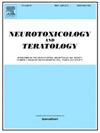Gene × environment interaction between heterozygous deletion of the ADHD risk gene latrophilin-3 (adgrl3) and developmental deltamethrin exposure in Sprague Dawley rats
IF 2.8
3区 医学
Q3 NEUROSCIENCES
引用次数: 0
Abstract
The prevalence of attention deficit hyperactivity disorder (ADHD) is 9.8 % in U.S. children. Several variants of Latrophiln-3 (LPHN-3) are associated with ADHD. Using CRISPR/Cas9 we deleted exon 3 in rats to create a global Lphn3 knockout. These rats are hyperactive, startle hyper-reactive, impulsive, and have impaired working, spatial, and egocentric learning and memory. Deltamethrin (DLM) is a widely used pyrethroid insecticide. Several epidemiological studies report an increase in ADHD prevalence in children exposed to pyrethroids. Developmental exposure to DLM in rats results in multiple behavioral deficits. The present experiment tested whether Lphn3 disruption interacts with developmental DLM exposure. Because Lphn3−/− rats are severely impaired, we used Lphn3+/− (Hets) because they have an intermediate phenotype. Rats were treated by gavage once/day from postnatal day 6–20 with DLM resulting in four groups: Lphn3-Het + DLM (1.0 mg/kg), Lphn3-Het + Corn Oil (CO), Lphn3+/+ (wildtype: WT) + DLM, and WT + CO. From 31 litters, 19–27 offspring per genotype per treatment per sex were obtained with not more than 1 rat of each group and sex used from any one litter. Adult offspring were tested for exploration (open-field), 72-h home-cage activity, startle, novel object recognition (NOR), radial water maze (RWM), Morris water maze (MWM), and Cincinnati water maze (CWM). On MWM acquisition trials and the reversal probe trial, Lphn3-Het-DLM rats performed worse than other groups. This group also was impaired learning the CWM. No interactions were found for open-field, home-cage, startle, NOR, or RWM. The results show that the ADHD risk gene Lphn3 in combination with developmental DLM exposure has selective adverse effects compared with either factor alone.
Sprague Dawley大鼠ADHD风险基因嗜乳蛋白-3 (latrophilin-3, adgrl3)杂合缺失与发育期溴氰菊酯暴露的基因×环境相互作用
注意缺陷多动障碍(ADHD)在美国儿童中的患病率为9.8% %。Latrophiln-3 (LPHN-3)的几种变体与ADHD有关。使用CRISPR/Cas9,我们在大鼠中删除了外显子3,以创建全局Lphn3敲除。这些老鼠过度活跃,惊吓过度反应,冲动,工作,空间和以自我为中心的学习和记忆受损。溴氰菊酯(DLM)是一种广泛使用的拟除虫菊酯类杀虫剂。几项流行病学研究报告称,接触拟除虫菊酯的儿童ADHD患病率有所增加。大鼠发育暴露于DLM会导致多种行为缺陷。本实验测试了Lphn3破坏是否与发育性DLM暴露相互作用。由于Lphn3-/-大鼠严重受损,我们使用Lphn3+/- (hts),因为它们具有中间表型。老鼠被填喂法在断奶后6 20天每天一次DLM导致四组:Lphn3-Het + DLM (1.0毫克/公斤),Lphn3-Het + 玉米油(CO), Lphn3 + / +(野生型:WT) + DLM,和WT + 有限公司从31窝中,每个处理每个性别获得每个基因型19-27只后代,每组不超过1只大鼠。对成年子代进行探索(野外)、72h家笼活动、惊吓、新目标识别(NOR)、径向水迷宫(RWM)、莫里斯水迷宫(MWM)和辛辛那提水迷宫(CWM)测试。在MWM获取实验和逆转探针实验中,Lphn3-Het-DLM大鼠表现较其他各组差。这组在学习CWM方面也有障碍。野外、家庭笼、惊吓、NOR或RWM均未发现相互作用。结果表明,ADHD风险基因Lphn3与发育性DLM暴露相结合,与单独的任何因素相比,具有选择性的不良反应。
本文章由计算机程序翻译,如有差异,请以英文原文为准。
求助全文
约1分钟内获得全文
求助全文
来源期刊
CiteScore
5.60
自引率
10.30%
发文量
48
审稿时长
58 days
期刊介绍:
Neurotoxicology and Teratology provides a forum for publishing new information regarding the effects of chemical and physical agents on the developing, adult or aging nervous system. In this context, the fields of neurotoxicology and teratology include studies of agent-induced alterations of nervous system function, with a focus on behavioral outcomes and their underlying physiological and neurochemical mechanisms. The Journal publishes original, peer-reviewed Research Reports of experimental, clinical, and epidemiological studies that address the neurotoxicity and/or functional teratology of pesticides, solvents, heavy metals, nanomaterials, organometals, industrial compounds, mixtures, drugs of abuse, pharmaceuticals, animal and plant toxins, atmospheric reaction products, and physical agents such as radiation and noise. These reports include traditional mammalian neurotoxicology experiments, human studies, studies using non-mammalian animal models, and mechanistic studies in vivo or in vitro. Special Issues, Reviews, Commentaries, Meeting Reports, and Symposium Papers provide timely updates on areas that have reached a critical point of synthesis, on aspects of a scientific field undergoing rapid change, or on areas that present special methodological or interpretive problems. Theoretical Articles address concepts and potential mechanisms underlying actions of agents of interest in the nervous system. The Journal also publishes Brief Communications that concisely describe a new method, technique, apparatus, or experimental result.

 求助内容:
求助内容: 应助结果提醒方式:
应助结果提醒方式:


